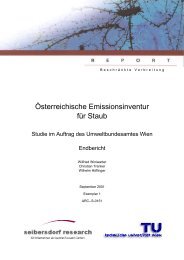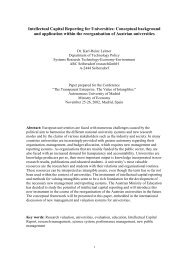ALPMON FINAL REPORT - ARC systems research
ALPMON FINAL REPORT - ARC systems research
ALPMON FINAL REPORT - ARC systems research
You also want an ePaper? Increase the reach of your titles
YUMPU automatically turns print PDFs into web optimized ePapers that Google loves.
Contract ENV4-CT96-0359 <strong>ALPMON</strong><br />
Over non vegetated areas a texture analysis method for the extraction of sealed surfaces was tested<br />
which gave interesting results over medium size settlements whereas over the minor settlements<br />
auxiliary information from the regional topographical map at scale 1:10,000 was necessary to improve<br />
the accuracy.<br />
Besides land cover, other auxiliary information over morphology, geology, soil and climate resulted to<br />
be essential for the development of the erosion risk model. Apart from morphological information (i.e.<br />
slope, aspect, elevation) computed from a DEM (derived from topographic maps at scale 1:25.000),<br />
the quality of the other auxiliary information turned out to be highly heterogeneous over the test site of<br />
Cordevole but this situation can be considered quite representative of Italian alpine regions.<br />
The FSTAB erosion risk model was designed to take into account a wide range of mass erosion<br />
phenomena specific of alpine areas. FSTAB differs from other erosion models because it does not<br />
provide an estimate of the erosion rate but an erosion risk index representing the propensity towards<br />
the generation of mass erosion. To allow the model to represent the erosion risk inside the test site<br />
area of Cordevole with a level of detail compatible with the customer requirements (scale 1:25.000)<br />
both a calibration based on a geological ground survey and a tuning of the fuzzy inference engine were<br />
necessary. FSTAB has demonstrated to be a flexible model because some input parameters<br />
potentially affecting the mass erosion risk can be even discarded, when their accuracy is not good<br />
enough, without preventing the model from working.<br />
3.3.9.5 Integration into CORINE land cover<br />
Objective of this work-package was the investigation on how far the results of <strong>ALPMON</strong> can support<br />
European activities such as the CORINE land cover project. While the CORINE land cover maps are<br />
based on visual interpretation of multi-spectral images such as Landsat TM or SPOT XS, the <strong>ALPMON</strong><br />
approach combines and classifies image data of various spectral and spatial resolutions with numerical<br />
methods. These different approaches towards the same objective lead to significant confusions<br />
between the single results.<br />
The agreement between the original classifications and the CORINE land cover maps of the test sites<br />
has been less than 50% in average. This “poor” agreement is partly due to the different degrees of<br />
generalisation of the land cover maps. While in CORINE the minimum mapping unit is 25 ha ( =<br />
250000 m 2 ), the <strong>ALPMON</strong> classifications refer to the single pixel, i.e. an area between 25 m 2 and 900<br />
m 2 depending on the image data applied. In order to overcome this contradiction of scale the <strong>ALPMON</strong><br />
classification results were post-processed using a generalisation technique. This technique allows to<br />
combine neighbouring pixels of different classes to larger objects of one heterogeneous class.<br />
Generalisation of the <strong>ALPMON</strong> classifications has its clear impact on the degree of agreement that<br />
could be increased by post-processing to almost 60% in average. Although an increase of 10% can be<br />
considered significant, and proves the effectiveness of the post-processing method, there is still about<br />
40% of confusion between the data sets that have to be explained. A part of it might be caused by the<br />
different approaches towards generalisation. Visual interpretation usually defines the dominant class in<br />
an image as “background” and “cuts out” the remaining classes. The post-processing technique is<br />
always limited to the local neighbourhood and therefore does not consider dominant classes in a larger<br />
environment.<br />
A major reason for the confusion between the data sets are the differences in the nomenclatures,<br />
despite the effort of harmonisation, or in the interpretation of the nomenclature. This is stated in the<br />
confusion between forest and shrubland or between meadows / pastures, sparse vegetation and rocks.<br />
Here the problem is a clear definition of class limits, both in terms of space and theme. Delineation of<br />
land cover types is critical, if the spatial transition is continuos, e.g. between forest and shrubland.<br />
Differentiation of land cover types is critical, if the thematic transition is continuos, e.g. between sparse<br />
vegetation and rocks. A significant difference can also be found in the interpretation of forest types.<br />
Mixed forest in <strong>ALPMON</strong> is to a high extent interpreted as coniferous forest in CORINE, while parts of<br />
coniferous forest in <strong>ALPMON</strong> are confused with natural grassland and heathland in CORINE. The<br />
latter is due to the fact that dwarf mountain pine was defined as heathland in the CORINE<br />
nomenclature. The over estimation of coniferous forest at costs of mixed forest in CORINE – as<br />
confirmed by aerial images – might be due to the differences in the original minimal mapping unit, i.e.<br />
the different approaches to generalisation.<br />
In general it has to be noted that the confusions in the different test sites do not show the same<br />
pattern. As a unique and reproducible processing chain was used in <strong>ALPMON</strong> to ensure comparable<br />
results for the test sites, it is likely that the CORINE data sets are not totally compatible. This becomes<br />
JR, RSDE, ALU, LMU, Seibersdorf, WSL 84




